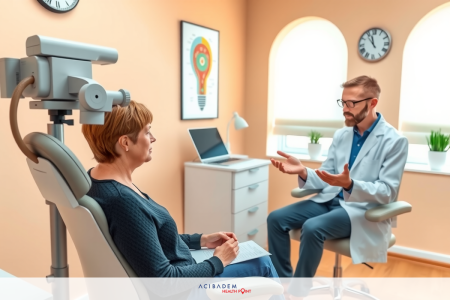Lagophthalmos in Bell’s Palsy Cases
Lagophthalmos in Bell’s Palsy Cases Bell’s Palsy is a condition that causes sudden facial paralysis. It greatly affects eye health. One issue that comes from it is lagophthalmos, making it hard to close the eyelids fully.
This problem can really change how you live your day and your life. The National Institute of Neurological Disorders and Stroke says it’s a big deal.
It’s key to know how Bell’s Palsy and lagophthalmos are linked for good treatment. The American Academy of Ophthalmology says it’s important to spot early signs. They also say finding the right treatment is key to avoiding more problems.
The Mayo Clinic says we must act fast to keep eyes healthy and help face recovery. This article will explain how Bell’s Palsy causes lagophthalmos. It will also cover how to treat it.
Introduction to Lagophthalmos and Bell’s Palsy
It’s important to know about lagophthalmos and Bell’s Palsy to manage them well. This part explains what each condition is and how they affect the body.
What is Bell’s Palsy?
Bell’s Palsy is a sudden facial nerve weakness. It can cause paralysis on one side of the face.
The Bell’s Palsy causes are not fully known. But, it’s thought to be from viral infections that swell the facial nerve.
The facial nerve helps with facial expressions, swallowing, and blinking. So, any damage can really affect these actions.
What is Lagophthalmos?
Lagophthalmos means you can’t fully close your eyelid. This happens when the muscles around your eyes don’t work right because of facial nerve weakness.
Not being able to close your eyelid fully can hurt your eye. It can make it dry and open to harm.
Doctors from places like Cleveland Clinic, MedlinePlus, and Johns Hopkins Medicine say it’s key to understand these conditions. This helps with the right treatment and care.
Causes of Lagophthalmos in Bell’s Palsy
Lagophthalmos often happens in people with Bell’s Palsy because of facial nerve damage. This damage, usually from idiopathic facial paralysis, hurts the muscles that close the eyelids. This leaves the eye open and at risk for more problems.
Many risk factors make getting Bell’s Palsy and lagophthalmos more likely. These include past viral infections, weak immune systems, and genes. The fact that Bell’s Palsy can happen suddenly makes it hard to stop lagophthalmos before it starts.
Studies by the American Academy of Neurology show that some facial paralysis has no clear cause. But, viruses like herpes simplex might start it, causing nerve damage. Facial Palsy UK says being pregnant, having diabetes, or high blood pressure also raises the risk of Bell’s Palsy and eye issues.
| Risk Factors | Frequency |
|---|---|
| Viral Infections | High |
| Compromised Immune System | Medium |
| Genetic Predisposition | Medium |
| Diabetes | Low |
| Hypertension | Low |
| Pregnancy | Low |
Knowing why lagophthalmos happens in Bell’s Palsy helps us find better ways to treat it. Even though we don’t fully understand Bell’s Palsy, research is ongoing. It aims to help us better manage these nerve issues and protect the facial nerves.
Symptoms Associated with Lagophthalmos
Lagophthalmos often comes with Bell’s Palsy. It has many symptoms that can really change your life. It’s key to know these symptoms to catch and treat it early. This part talks about the usual and serious symptoms seen in people with this condition.
Common Symptoms
People with lagophthalmos often have these symptoms:
- Dry eyes: Not being able to fully close your eyelids makes your eyes dry. This is because they don’t get enough moisture.
- Corneal exposure: When your eyelids don’t close all the way, your cornea gets exposed. This can make it hurt and feel uncomfortable.
- Blurred vision: Dry eyes and corneal exposure can make your vision blurry. This happens because your eyes aren’t getting the moisture they need.
Severe Symptoms
In worse cases, lagophthalmos can lead to serious problems. These need quick medical help:
- Facial asymmetry: Bell’s Palsy can make one side of your face look different from the other.
- Acute symptoms: These include a lot of eye pain, serious corneal damage, and ulcers. This happens because your eyes are open too long and don’t get protected.
Spotting these symptoms early helps you take action. This can prevent more serious problems later.
How Bell’s Palsy Leads to Lagophthalmos
Bell’s Palsy is a sudden condition caused by nerve inflammation. It mainly affects the facial nerve, or the seventh cranial nerve. This nerve helps control the muscles for facial expressions.
When the nerve gets inflamed, it can’t work right. This leads to facial muscle control loss. The eyelid can’t close fully, causing lagophthalmos.
The symptoms start with mild facial weakness and can lead to full paralysis on one side. This paralysis messes with the normal way facial muscles work together. This is called synkinesis.
Sometimes, the nerves grow back wrong, causing muscles to move on their own. This makes it harder for facial muscles to work right.
The inflammation and damage to the facial nerve mess up the signals to facial muscles. The eyelid muscles don’t get the signals they need. This leads to the eyelid not closing fully, or lagophthalmos.
This whole process shows how nerve inflammation, synkinesis, and muscle loss lead to lagophthalmos in Bell’s Palsy.
Knowing how this happens helps doctors treat lagophthalmos better. They can help at each stage of the symptoms.
Diagnosis Methods for Lagophthalmos in Bell’s Palsy Patients
Doctors use many ways to check for lagophthalmos in Bell’s Palsy patients. They use both simple checks and high-tech tools for a full check-up.
Physical Examination
The first step is a physical check-up. Doctors look at how well the patient can shut their eyelids. They also check for any eye problems.
They use a special lamp to look at the eye closely. This helps them see if the tear production is okay, which is important for diagnosing lagophthalmos.
Imaging Techniques
Imaging tools help see what’s going on inside the body. An MRI shows the nerves in the head. This helps doctors find nerve problems or damage.
A CT scan looks at the bones and finds any issues that might affect the nerves. Tests like EMG and nerve conduction studies check how the nerves work. They help find where the nerve problems are.
| Diagnosis Method | Purpose | Tools |
|---|---|---|
| Physical Examination | Assess eyelid function and tear production | Slit Lamp |
| MRI | Detect nerve inflammation or damage | Magnetic Resonance Imaging |
| CT scan | Evaluate bony structures | Computed Tomography |
| Electrodiagnostics | Assess nerve functionality | EMG, Nerve Conduction Studies |
By using these different ways to check, doctors can find out if a patient has lagophthalmos from Bell’s Palsy. They can then make a good plan for treatment.
Treatment Options for Lagophthalmos
Managing lagophthalmos often means using both medical and surgical treatments. Each plan is made just for the person and their symptoms.
Medical Treatments
There are many medical ways to help with lagophthalmos:
- Corticosteroids: These drugs help lessen swelling and make nerves work better. Drugs Journal shows they work well for Bell’s Palsy.
- Neuroprotective agents: These help protect and heal nerve tissues. They make eye movements better and lower the chance of eye damage.
Surgical Solutions
If meds don’t work, surgery can help a lot with lagophthalmos:
- Eyelid weights: Tiny weights are put in the upper eyelid to help with blinking. The American Society of Plastic Surgeons suggests this often.
- Tarsorrhaphy: This means sewing the eyelids together a bit. It makes the opening smaller and protects the cornea.
- Reconstructive surgery: For very bad cases, more surgery is needed. It helps fix eyelid function and protect the eye.
Importance of Early Detection
Finding lagophthalmos early in Bell’s Palsy patients is key. It helps make treatments work better and improves recovery chances. A quick diagnosis means acting fast, which lowers risks and boosts recovery odds.
Spotting early signs like trouble closing eyes and dry eyes is vital. Doctors must act quickly in these cases. This quick action improves care quality and helps patients get better faster.
Research in Clinical Interventions in Aging, Patient Care, and the Family Practice journal shows early action is crucial. They point out that quick diagnosis links to better recovery. Doctors need to watch closely and act fast.
So, catching lagophthalmos early means starting the right treatments on time. This approach leads to better care and helps people with lagophthalmos from Bell’s Palsy recover more effectively.
Non-Surgical Management and Home Care
Managing lagophthalmos at home is key for eye health. Here are some tips to protect your cornea and ease symptoms.
Eye Care Routine
Start a daily eye care routine to help with lagophthalmos. Clean your eyelids with a gentle solution to prevent irritation. Check your eyes often for dryness or redness to act fast if needed.
Do eyelid closure exercises regularly. These help make your eyelid muscles stronger. This means they can close better, protecting your cornea.
Using Eye Drops and Ointments
If your eyes feel dry, artificial tears can help. These drops add moisture and ease discomfort. Use lubricating ointments at night for extra protection.
Always use these products as your doctor says to avoid side effects.
- Use artificial tears all day to keep your eyes wet.
- Put lubricating ointments on before bed for night protection.
Adding these steps to your daily routine can help manage lagophthalmos. Keep an eye on your eye health and care for it well. This helps avoid more problems and keeps your cornea safe.
Rehabilitation and Recovery
Rehab for lagophthalmos after Bell’s Palsy needs a full plan. This plan includes physical therapy and facial exercises. The main goal is to make the face work better and look even again. This makes life better for the patient.
Physical therapy is key in getting better. Therapists make special programs with facial exercises. These exercises help make muscles strong and work together better. Neuromuscular retraining also helps fix how nerves talk to muscles, which is key for moving the face.
How long it takes to get better depends on how bad the nerve damage is and how well the patient follows the rehab plan. Some start to see changes in a few weeks. Others might need a few months of therapy to see big improvements. Being patient and sticking with the exercises and therapy is very important for getting better.
Here’s a quick look at some therapies and how long they might take:
| Therapy | Description | Expected Timeline |
|---|---|---|
| Facial Exercises | Daily routines to strengthen facial muscles | 4-8 weeks |
| Neuromuscular Retraining | Exercises focused on nerve-muscle coordination | 3-6 months |
| General Physical Therapy | Includes massage and electrotherapy | 2-4 months |
In short, a good rehab plan with facial exercises, physical therapy, and neuromuscular retraining is key for getting over lagophthalmos from Bell’s Palsy. How fast you get better depends a lot on how hard you work at it.
Long-Term Effects of Untreated Lagophthalmos
Lagophthalmos can cause serious health problems if not treated. It’s key to deal with it quickly. This part talks about the risks and how to avoid them.
Potential Complications
Not treating lagophthalmos can be very bad. It can hurt the eyes and cause infections. These problems can make life hard.Lagophthalmos in Bell’s Palsy Cases
It’s important to get help fast. If not, it could lead to losing sight or even going blind.
Prevention Strategies
It’s important to take care of your eyes to avoid problems. Doctors should check on you often to catch issues early. Keeping your eyes moist and safe helps too.
Telling patients why these steps are important helps them follow their treatment. This keeps their eyes healthy and their life better.Lagophthalmos in Bell’s Palsy Cases
The Role of Acibadem Healthcare Group in Treating Bell’s Palsy
Acibadem Healthcare Group is known for treating Bell’s Palsy well. They have top-notch facilities and skilled doctors. They offer many services for Bell’s Palsy patients.
They use a team of neurologists, ophthalmologists, and physiotherapists. This team makes sure patients get a full treatment plan. It covers the brain and eye parts affected by Bell’s Palsy.
Advanced diagnostics are key at Acibadem Healthcare Group. They use the latest imaging to find Bell’s Palsy early. This helps stop Lagophthalmos from happening. It also means treatments can be more precise and effective.
Acibadem stresses the need to act fast. The first stages of Bell’s Palsy are very important. They want people to get help right away. They teach patients about their condition and treatment options.
Here is a detailed overview of the treatment approaches utilized by Acibadem Healthcare Group:
| Treatment Component | Description |
|---|---|
| Initial Assessment | Comprehensive evaluation to diagnose Bell’s Palsy and assess the severity of Lagophthalmos. |
| Medical Therapy | Use of medications to manage symptoms and prevent further nerve damage. |
| Physical Therapy | Customized exercises to enhance facial muscle function and reduce the impact of Lagophthalmos. |
| Surgical Solutions | Advanced surgical techniques to correct severe cases of Lagophthalmos caused by Bell’s Palsy. |
| Ongoing Monitoring | Regular follow-ups to monitor recovery progress and adjust treatment plans as necessary. |
Acibadem Healthcare Group uses new treatments, careful patient checks, and quick action. They are dedicated to making life better for people with Bell’s Palsy and its problems.
Success Stories and Patient Experiences
Living with lagophthalmos from Bell’s Palsy is tough. But many patients have found ways to manage it well. Sarah got facial paralysis suddenly. Her doctors and eye care routine helped her a lot.
She used eye drops and got the right treatments on time. This helped her feel better and do her daily stuff again.
David found out how important good care is. Bell’s Palsy hit him hard at first. He got help from the Acibadem Healthcare Group.Lagophthalmos in Bell’s Palsy Cases
With physiotherapy and special doctor visits, he got much better. David shows how important it is to keep trying and get the right help.
Emily had a tough time with lagophthalmos that wasn’t treated. But she didn’t give up. With help from eye doctors, she got surgery that changed her life.
Her story shows how important it is to see a doctor fast and get the right treatment. These stories prove that with the right care, people can beat Bell’s Palsy.
FAQ
What is Bell's Palsy?
Bell's Palsy is a type of temporary facial paralysis. It happens when the facial nerves get damaged. This leads to muscle weakness or paralysis on one side of the face. It can make it hard to close one eye fully. This can hurt eye health.
What is Lagophthalmos?
Lagophthalmos means your eyelids don't close fully. This can make your eye dry and irritated. It's often seen in people with Bell’s Palsy.
What causes lagophthalmos in Bell's Palsy patients?
The facial muscles that control eyelid movement get paralyzed. This happens because of nerve inflammation and damage. It leads to eye problems.
What are common symptoms associated with lagophthalmos?
People with lagophthalmos may have dry eyes, blurry vision, and eye irritation. Their face might look uneven too. This can make it hard to protect their eyes.
How does Bell's Palsy lead to lagophthalmos?
Bell's Palsy causes nerve inflammation and muscle loss. This affects the muscles that close the eyelid. So, people can't close their eyelids fully.
What are the diagnosis methods for lagophthalmos in Bell's Palsy patients?
Doctors check the facial nerves during an exam. They might use MRI or CT scans to look for nerve problems. Tests like electrodiagnostics check nerve damage.
What medical treatments are available for lagophthalmos?
Doctors use corticosteroids to reduce swelling and help the nerves. They also suggest eye drops and ointments to keep the eyes moist.
What surgical solutions are available for lagophthalmos?
Surgery can help by adding eyelid weights or sewing the eyelid shut. For severe cases, surgery can improve eyelid function and eye health.
How important is early detection in treating lagophthalmos?
Finding it early makes treatment work better. It helps prevent long-term eye problems. People should see a doctor right away if they notice symptoms.
What non-surgical management and home care options exist for lagophthalmos?
You can keep your eyes moist with artificial tears and ointments. Doing this helps prevent eye problems and manage symptoms.
What rehabilitation and recovery options are available for Bell's Palsy and lagophthalmos?
Rehabilitation includes exercises and physical therapy. These help improve muscle control and facial symmetry. It can help people recover faster.
What are the long-term effects of untreated lagophthalmos?
Not treating it can cause eye damage and lower quality of life. It can lead to serious problems like corneal ulcers. Regular eye care is key to avoiding these issues.
What role does Acibadem Healthcare Group play in treating Bell's Palsy?
Acibadem Healthcare Group offers expert care for Bell's Palsy and related conditions. They have a team that creates personalized treatment plans to help patients recover and keep their eyes healthy.
Are there any success stories or patient experiences regarding treatment of Bell's Palsy?
Many people have gotten better from Bell's Palsy and share their stories. These stories offer hope and advice to others facing the same issues.













